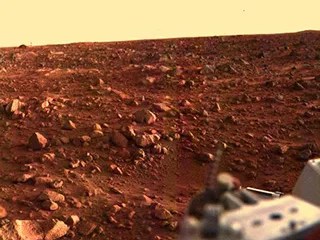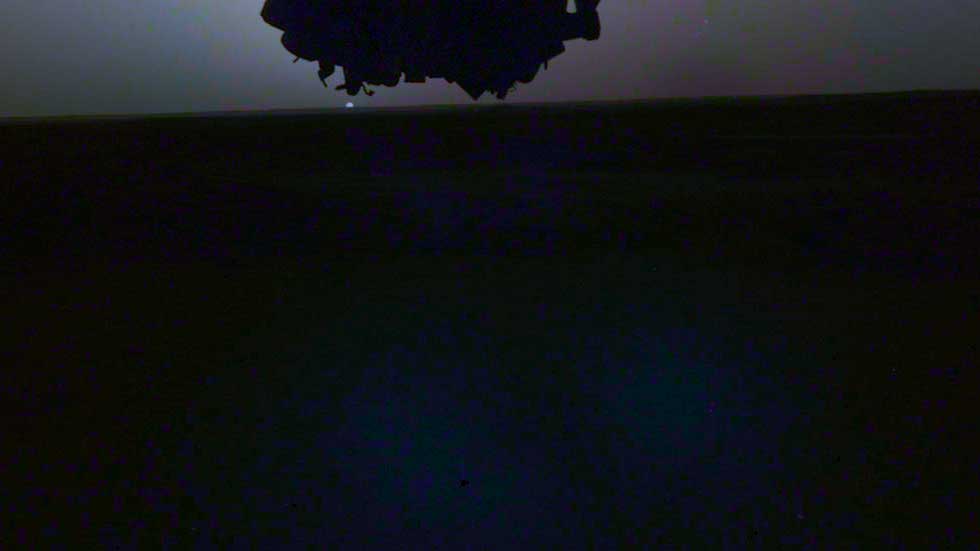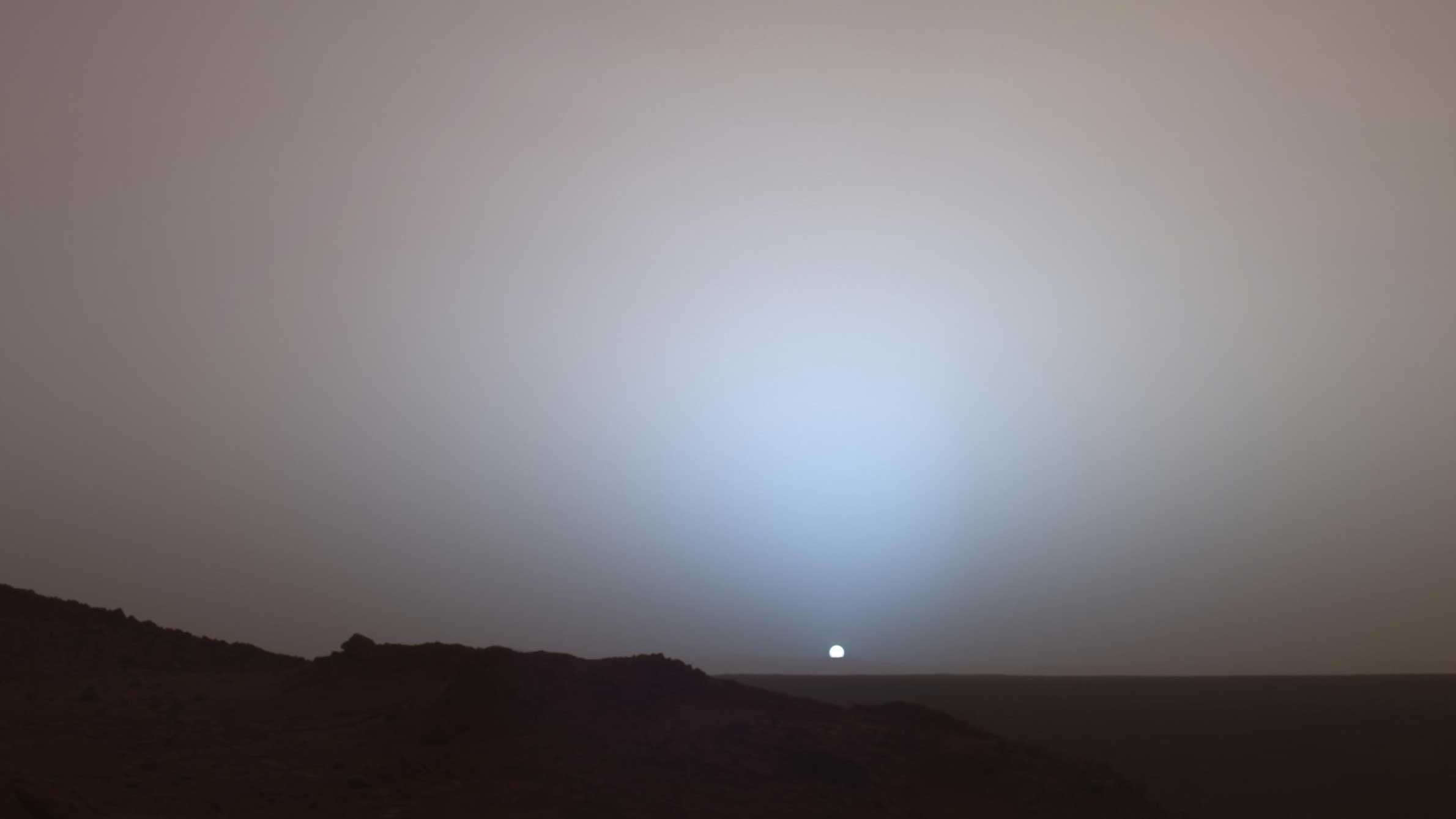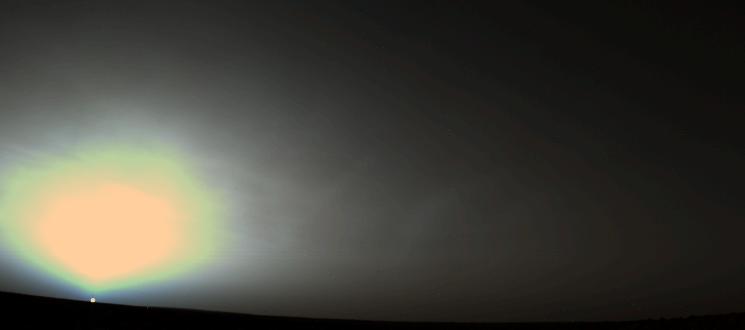5 min read

NASA's Viking 1 lander first showed humans what a sunset looked like on Mars. The image above shows the Chryse Planitia region of Mars about 15 minutes before sunset on Aug. 21, 1976. The low Sun angle highlights topographic features:
- A depression is visible near the center of the picture, just above the lander's leg support structure, which was not evident in previous pictures taken at higher Sun angles.
- Just beyond the depression are large rocks about 1 foot (30 centimeters) across.
- The diffuse shadows are due to the sunlight that has been scattered by the dusty Martian atmosphere as a result of the long path length from the setting Sun.
- Toward the horizon, several bright patches of bare bedrock are revealed.
Since the Viking 1 mission, NASA has launched several robotic missions to the Red Planet. They have sent back a variety of views of Martian sunrises and sunsets. Because Mars is farther from the Sun than Earth, the Sun appears only about two-thirds the size we see when we watch sunsets here on Earth. Some images have been color-corrected to show what human explorers might one day see while relaxing after a hard day's work on Mars. Here are some of those images:

This sunset on Mars was captured by NASA's Perseverance Mars rover using its Mastcam-Z camera system on Nov. 9, 2021, the 257th Martian day, or sol, of the mission. Martian sunsets typically stand out for their distinctive blue color. Fine dust in the atmosphere permits blue light to penetrate the atmosphere more efficiently than colors with longer wavelengths. But this sunset looks different: less dust in the atmosphere resulted in a more muted color than average. The color has been calibrated and white-balanced to remove camera artifacts.

NASA’s Curiosity Mars rover captured these "Sun rays" shining through clouds at sunset on Feb. 2, 2023, the 3,730th Martian day, or sol, of the mission. It was the first time that Sun rays, also known as crepuscular rays, have been viewed so clearly on Mars. Crepuscular is taken from the Latin word for “twilight,” as these rays appear near sunset or sunrise.

NASA's InSight lander used its Instrument Deployment Camera (IDC) on the spacecraft's robotic arm to image this sunrise on Mars on April 24, 2019, the 145th Martian day (or sol) of the mission. This image was taken around 5:30 am Mars local time.

NASA's Mars Exploration Rover Spirit captured this stunning view as the Sun sank below the rim of Gusev crater on Mars on May 19th, 2005.
This Panoramic Camera (Pancam) mosaic was taken around 6:07 in the evening of the rover's 489th Martian day, or sol. Spirit was commanded to stay awake briefly after sending that sol's data to the Mars Odyssey orbiter just before sunset.
In this image, the bluish glow in the sky above the Sun would be visible to us if we were there, but an artifact of the Pancam's infrared imaging capabilities is that with this filter combination the redness of the sky farther from the sunset is exaggerated compared to the daytime colors of the Martian sky.

NASA's Viking 2 Lander captured this view of a Martian sunrise on June 14, 1978, at the spacecraft's Utopia Planitia landing site.
The data used to create this was acquired just as the Sun peaked over the horizon on the Lander's 631st sol (Martian solar day). Pictures taken at dawn (or dusk) are quite dark except where the sky is brightened above the Sun's position. The glow in the sky results as light from the Sun is scattered and preferentially absorbed by tiny particles of dust and ice in the atmosphere.
Mars is known as the Red Planet because of iron oxide (like rust) in its soil. The planet's distinctive reddish hue is visible from Earth even without the aid of a telescope. The ancient Romans named it for their God of War (Ares in Greek mythology).
So what's with the blue twilight?
Just as colors are made more dramatic in sunsets on Earth, Martian sunsets would appear bluish to human observers watching from the Red Planet. Fine dust makes the blue near the Sun's part of the sky much more prominent, while normal daylight makes the Red Planet's familiar rusty dust color more prominent.
"The colors come from the fact that the very fine dust is the right size so that blue light penetrates the atmosphere slightly more efficiently," said Mark Lemmon of Texas A&M University, College Station, a science team member of the Curiosity rover mission. "When the blue light scatters off the dust, it stays closer to the direction of the Sun than light of other colors does. The rest of the sky is yellow to orange, as yellow and red light scatter all over the sky instead of being absorbed or staying close to the Sun."
These images are more than just beauty shots. Martian sunset and twilight images help scientists determine how high into the atmosphere the Martian dust extends, and allow them to look for dust or ice clouds.
Other images have shown that the twilight glow remains visible, but increasingly fainter, for up to two hours before sunrise or after sunset. The long Martian twilight (compared to Earth's) is caused by sunlight scattered around to the night side of the planet by abundant high altitude dust.
Similar long twilights or extra-colorful sunrises and sunsets sometimes occur on Earth when tiny dust grains that are erupted from powerful volcanoes scatter light high in the atmosphere.
